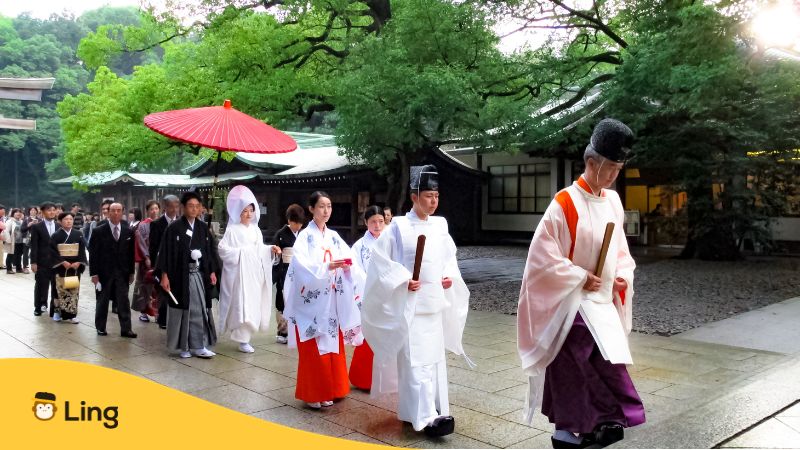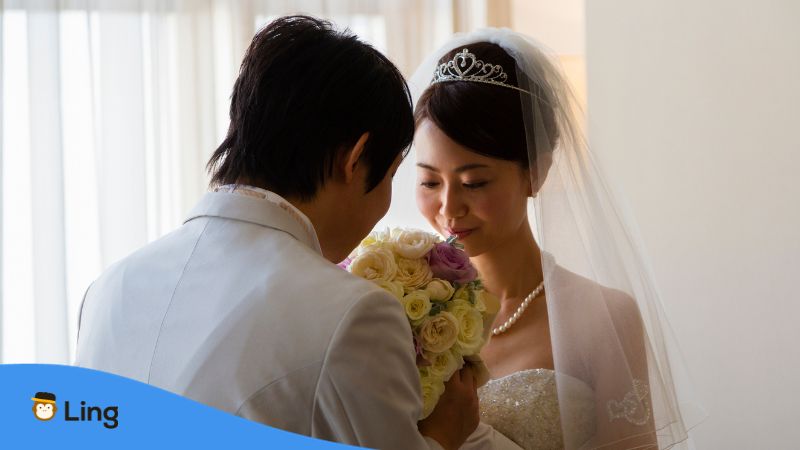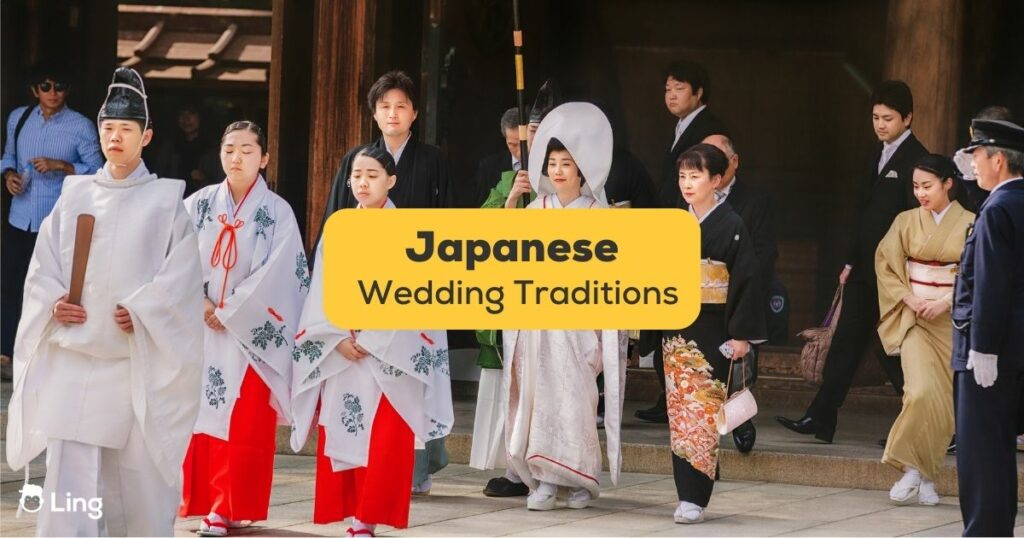Japan is a land of rich traditions, and its wedding ceremonies are no exception. While a modern Japanese wedding ceremony may seem more Westernized than traditional, they still incorporate a fascinating blend of ancient customs and contemporary style.
Let’s explore these Japanese wedding traditions, each with its own unique significance!
Japanese Wedding Traditions
We know that Japanese culture is a fusion of the ancient and modern. Let’s see how Japanese people mix a traditional Japanese wedding and western style wedding together and do a bit of both!
1. The Betrothal Ceremony (Yuinou)
In Japan, the journey to matrimony begins with the betrothal ceremony, known as “Yuinou.” This time-honored ritual involves the exchange of symbolic gifts between the families of the bride and groom.
Traditionally, these gifts included items like konbu (seaweed), representing a wish for fertility, a white piece of hemp symbolizing growing old together, and a folding fan, signifying future wealth and growth. However, modern Yuinou ceremonies have become more casual, often taking the form of a family lunch or dinner. The betrothal money and gifts exchanged serve as a gesture of goodwill and unity between the two families.
2. Sake-Sharing Ceremony (San San Kudo)
While many contemporary Japanese weddings have adopted Western-style elements, the sake-sharing ceremony remains a cherished tradition in Shinto weddings. During this ritual, sacred sake cups are exchanged between the bride and groom, symbolizing their bond. The significance lies not only in the exchange of vows and rings but also in the sharing of sake, a practice dating back over a century.
There are three types of sake cups, each with its own meaning: small for gratitude toward ancestors, medium for aspirations to work together, and large for the wish to build a happy family and pledge eternal love. The bride, groom, and their parents each take three sips, totaling nine sips, cementing the connection between the families.
3. Selecting Auspicious Wedding Dates
In the quest for a harmonious and prosperous marriage, some Japanese couples turn to an ancient practice known as “Rokuyo.” This fortune-telling system helps determine the most auspicious wedding date. Originating from China, Rokuyo divides days into various categories, with “Taian” considered the most auspicious and “Butsumets” the least.
Couples often aim to schedule their weddings on Taian days for the best possible start to their married life. While parents still consider this practice, many young couples today prioritize other factors when choosing their wedding date, making it a tradition with varying degrees of importance.

4. Daytime Weddings: A Unique Japanese Timing
In Japan, weddings typically take place during the daytime, contrasting with the Western preference for evening ceremonies. The most popular timing for Japanese weddings is a late-morning ceremony followed by a formal lunch reception. This timing allows couples to enjoy the festivities during the day and reflects a more formal atmosphere. While Western weddings feature dancing and evening celebrations, Japanese weddings prioritize a daytime affair followed by an after-party where guests can let loose and dance.
5. In-House Vendors: A One-Stop Wedding Shop
Japanese wedding venues are known for their comprehensive offerings. Unlike Western weddings where couples often assemble their own vendor teams, Japanese venues handle everything in-house. This includes floral arrangements, photography, dress rentals, and makeup services. Couples typically decide from pre-packaged options offered by the venue, limiting the flexibility to bring in external vendors. This streamlined approach ensures that every aspect of the wedding is meticulously coordinated, simplifying the planning process for the couple.
6. Bouquet & Letter To Honor The Parents
Japanese wedding receptions feature a touching tradition where the bride and groom present a bouquet and a heartfelt letter to their parents. This emotional moment signifies the gratitude and appreciation the couple has for their families. It underscores the idea that marriage is not just a union between two individuals but a connection between two families. Guests are moved to tears during this touching exchange, highlighting the deep cultural emphasis on family bonds.
7. Formal Reception Without Dancing
Unlike Western weddings, the Japanese wedding reception tend to be formal affairs with less emphasis on dancing. The reception is a highly organized event, typically attended primarily by family members. Dancing typically takes place at after-parties, where friends gather to celebrate and dance the night away. The formal nature of Japanese receptions is characterized by sit-down lunches, speeches from superiors or bosses, and a “sake” toast to mark the occasion.
8. Monetary Gifts (Goshugi)
When attending a Japanese wedding, guests often come bearing gifts of cash, known as “Goshugi.” The amount varies based on the guest’s relationship to the couple. Friends typically offer around ¥30,000 (about $300), while bosses or teachers might give ¥50,000 (about $500). Relatives may offer larger sums, ranging from ¥50,000 to ¥100,000 (about $1,000).
These gifts are traditionally wrapped in a special envelope called “shugi-bukuro,” which is adorned with gold and silver strings that are intentionally difficult to untie. The presentation of crisp, new bills in these envelopes symbolizes good fortune for the newlyweds.

9. Gifts For Guests (Hikidemono)
In the spirit of hospitality and gratitude, Japanese couples often present gifts, known as “hikidemono,” to their wedding guests. These gifts can include a range of items, such as spa experiences or afternoon tea options. In recent times, guests have the opportunity to select their preferred gifts from a catalog, making it a thoughtful and personalized gesture. Additionally, as guests leave the wedding venue, couples offer small parting gifts, typically including sweets, bath salts, candles, and other tokens of appreciation.
10. Dress Rentals And Multiple Outfit Changes
Rather than purchasing wedding attire, many Japanese brides opt to rent their dresses, which may include both traditional kimono and Western-style white wedding dress. This practice reflects the practicality of keeping the attire clean, as Japanese weddings do not involve extensive dancing. Furthermore, brides typically wear multiple wedding dresses during the wedding day, transitioning from a traditional white kimono for the ceremony to a colorful dress for the reception. This allows them to showcase different styles and colors throughout the celebration.
11. Wedding Portraits: A Formal Affair
In Japanese wedding photography, there is a strong emphasis on formal portraits. The focus is on capturing meticulously posed shots, and the coverage may be limited compared to Western weddings. Couples often schedule portrait sessions before or after the wedding day, known as “Maedori” and “Atodori,” respectively. This approach allows them to create timeless and elegant images in a controlled setting, separate from the hustle and bustle of the actual ceremony and reception.
12. Tips For Guests: Cultural Considerations
Attending a Japanese wedding comes with its own set of cultural considerations. For example, when attending a Shinto wedding, it’s essential to wear socks or stockings, as going barefoot at the shrine is considered disrespectful. There are also specific dress codes to adhere to, as certain colors and jewelry choices are considered inauspicious. Japanese wedding culture places great importance on TPO (Time, Place, and Occasion/Opportunity), so guests should ensure their attire aligns with the formality of the event.
Japanese Vocabulary For Weddings
Conclusion
In conclusion, Japanese weddings beautifully blend ancient customs with modern celebrations, creating unique and meaningful ceremonies that reflect the country’s rich cultural heritage. These traditions and rituals, from the betrothal ceremony to the sake-sharing ritual, capture the essence of unity, gratitude, and familial bonds that are at the heart of Japanese wedding culture. While elements of Western influence are present, these customs continue to be cherished, making Japanese weddings a captivating and harmonious blend of the old and the new.
Start Learning Japanese With Ling!
If you’re interested in learning Japanese, Ling is a great resource to try. With its user-friendly interface, interactive lessons, and real-life vocabulary, Ling offers an immersive language learning experience.
Whether you want to improve your proficiency in Japanese or start from scratch, Ling provides a comprehensive platform for learners of all levels. From essential vocabulary to useful phrases and sentence structures, Ling offers a structured Japanese course that will help you build a strong foundation in the Japanese language.
Download Ling from the App Store or Play Store now!



































































